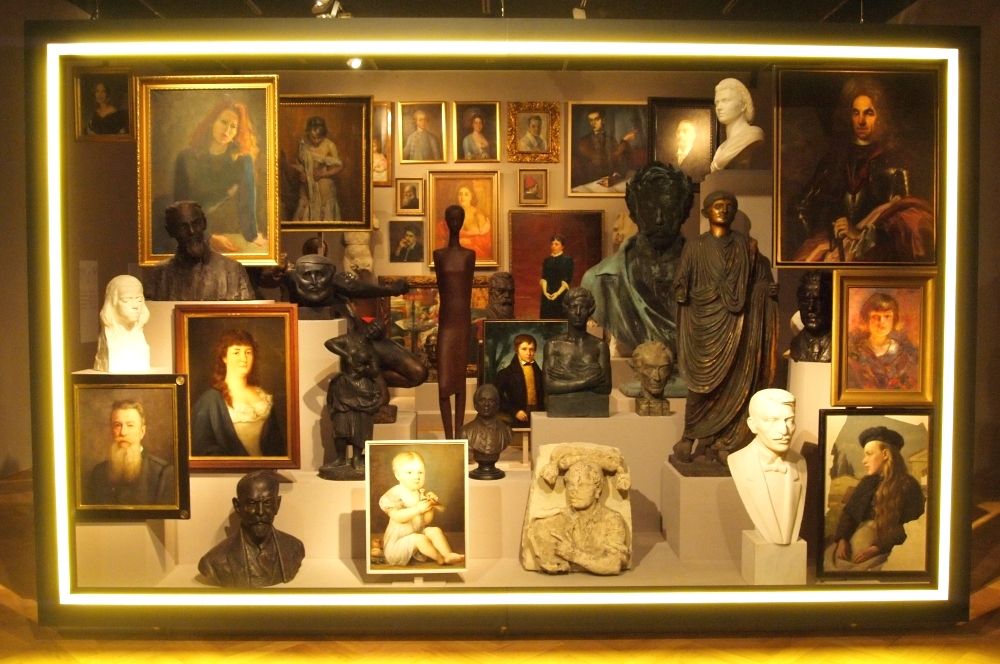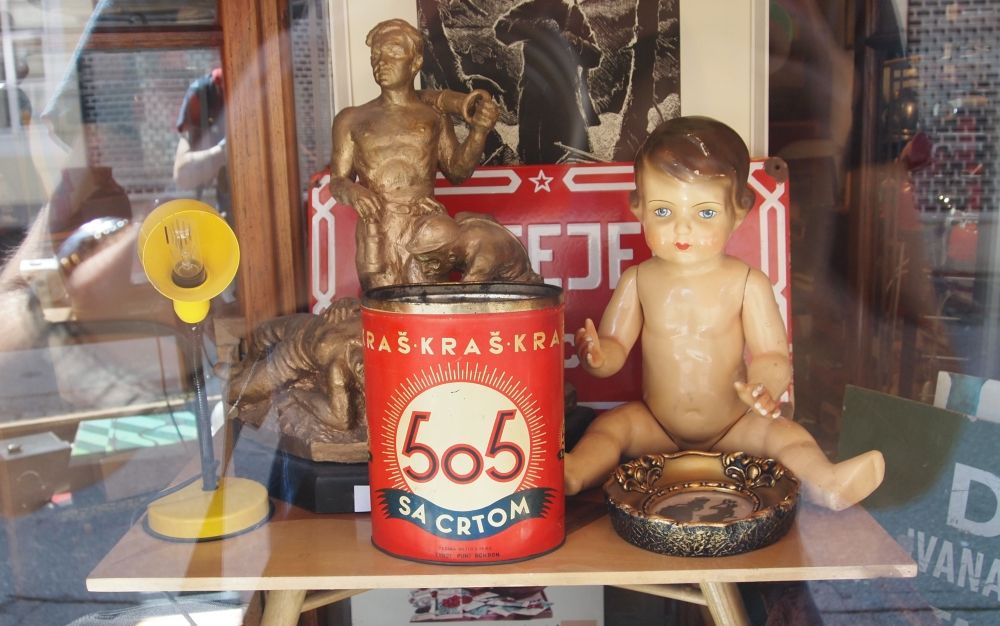News
STA - Below is a roundup of major events on Monday, 25 March:
Minister nominee Šabeder to strive for accessible, quality healthcare
LJUBLJANA - The nominee for health minister, Aleš Šabeder, stressed in his presentation at the Health Committee in parliament that citizens must be provided with accessible and quality public health services. The current director of the UKC Ljubljana hospital announced a systematic approach to cut waiting times and red tape, and an overhaul of the healthcare and health insurance act. MPs had several questions for him, mostly to do with supplementary insurance and problems in primary healthcare, but due to the abundance of questions the hearing will continue on Tuesday. If appointed, Šabeder will replace Samo Fakin, who resigned at the beginning of March for health reasons.
Zajc pledges to resume work set out by Environment Ministry
LJUBLJANA - Simon Zajc pledged to complete the work set out by his predecessor at the Ministry of the Environment and Spatial Planning in his hearing on the parliamentary committee in charge of the environment. He listed updates to construction and housing laws, a reform of water law and tackling the waste management as his priorities. Zajc, who is serving as one of the two state secretaries at the ministry and was nominated to replace his boss Jure Leben as minister, told the MPs the ministry would have to keep up the pace and the manner of work set out under Leben's guide. He is expected to be appointed minister on Wednesday after being backed in a 10:5 vote in today's hearing.
PM in acrimonious exchange with MP over Strasbourg address
LJUBLJANA - The National Assembly witnessed an acrimonious exchange between PM Marjan Šarec and opposition New Slovenia (NSi) MP Ljudmila Novak over his decision to pass on the invitation to address the European Parliament. While Novak, a former MEP, said that Šarec had missed an opportunity to set out his vision of the EU's future, the prime minister said he did not believe she had raised the issue in good faith, but rather as part of the campaign for the EU elections in which she stands herself as the NSi frontrunner herself. He said he did not regret his decision after Antonio Tajani's latest comments about Mussolini.
PM says real pension reform still in the making
LJUBLJANA - PM Marjan Šarec told MPs in questions time that the package of legislative changes to the pension system presented by the government recently addressed only the most burning issues, while a real reform was yet to be drawn up at a later stage. "These proposals are aimed at prolonging the years of service on the one hand and improving the social status of all those eligible for pension and disability insurance funds on the other," he said, arguing these would suffice for now.
Home minister says police managing situation on border
LJUBLJANA - Interior Minister Boštjan Poklukar assured MPs in questions time Slovenia was successfully managing migrations on the border with Croatia and protecting the Schengen border despite a renewed jump in illegal migrations. The latest data by police for January and February show a total of 611 illegal crossings of the border were recorded in Slovenia, up 35% compared to the same period last year. But the trend appears to have accelerated in March, with Poklukar saying 746 attempts to cross the border illegally had been recorded between 1 and 21 March. "It is true, attempts to cross the border illegally are increasing, partially due to the fact that the winter has been green ... which made it easier to cross the border."
Govt ratings down as scandals bite
LJUBLJANA - The government's approval rating appears to be eroding fast after the fourth cabinet resignation in six months. Having peaked in January at almost 63% and then dropping to 56% in February, it declined to 52.4% in the latest poll commissioned by POP TV. Over 36% said they disapproved of its performance, up four points over the previous month, while 11% were undecided, showed the poll, conducted by Mediana and released on Sunday evening. The declining approval rating was mirrored in the support for government parties, with the ruling Marjan Šarec List (LMŠ) losing four percentage points to 16.6%.
Cerar meets minority reps from Austria
LJUBLJANA - Foreign Minister Miro Cerar met representatives of the Slovenian minority from Austria as part of preparations for a session of the Slovenia-Carinthia Committee in Slovenia on Friday, which will also be attended by Carinthian Governor Peter Kaiser. The presidents of the umbrella minority organisations outlined the open issues which Cerar is expected to raise, pointing to the need to fully implement a memorandum from 2011 regarding bilingual place names in Carinthia. Cerar said more funding was needed for Slovenians not only in Carinthia but also Styria, chiefly for minority education and for the Slovenian weekly Novice.
Gorenje ends 2018 in the red, revenue down 1.7%
VELENJE - Household appliance maker Gorenje, which was taken over by China's Hisense last year, reported EUR 1.184bn in group sales revenue for 2018, a 1.7% drop on 2017. After ending 2017 in the black, Gorenje recorded a EUR 37.3m net loss in 2018, or EUR 111.2m when factoring in one-off and extraordinary events. EBITDA fell by 53.5% to EUR 29.6m and EBIT was EUR 28.2m in the negative after a EUR 12.1m plus had still been recorded in 2017. The company earmarked 2.5% of total revenue or EUR 30m for investment.
Slovenian, Macedonian economy ministers discuss economic ties
LJUBLJANA - Minister of Economic Development and Technology Zdravko Počivalšek and his Macedonian counterpart Kreshnik Bekteshi shared a view that bilateral economic relations were good, but called for further improving them, as they met in Ljubljana. "Trade in goods between the two countries reached EUR 307m in 2018, up 6% on 2017. The growth trend has also been recorded in services," Počivalšek was quoted as saying in his ministry's release. Bekteshi meanwhile noted that NATO's door opening for his country had brought stability and security, which facilitated a record growth in investment, topping EUR 624m.
Business sentiment flat in March, worsens y/y
LJUBLJANA - Business sentiment in Slovenia remained at 9.1 percentage points in March, level with February, but declined by 3.2 points from March 2018, the Statistics Office reported. The monthly trend was affected positively by a 0.4-point boost in the confidence indicators in manufacturing and retail. However, the overall indicator was kept down by a dampening in the services sector (-0.6 pp), among consumers (-0.2 pp) and in construction (-0.1 pp). Confidence in retail increased by one percentage point year-on-year.
Home prices in Slovenia up 18% in 2018
LJUBLJANA - Prices of residential properties in Slovenia rose by 18.2% last year, driven by a 19.8% growth in the prices of second-hand homes, according to a report by the Statistics Office. The number of transactions decreased by 14% to 9,421 from the 2017 peak. The number of transactions in new apartments remained low for the second year running. In the final quarter of 2018, prices of existing family houses increased the most, by as much as 38.6% compared to the same quarter a year ago.
Investment in digital ads expected to rise by 25% this year
LJUBLJANA - Advertisers in Slovenia will increase investment into digital advertising by 25% this year, spending an average of EUR 290,000 on it, suggests a survey carried out by the digital agency Iprom and pollster Valicon. Iprom said that 68% of the 214 surveyed decision-makers on the Slovenian advertising and marketing scene said they would increase the budget for digital advertising this year, while 29% said they would leave it on a par with last year's. The service sector will spend the most on digital advertising, EUR 352,000 on average, followed by the retail (EUR 291,000) and tourism sectors (EUR 233,000).
Petrol prices up significantly, diesel cheaper
LJUBLJANA - Regular petrol sold at service stations outside the Slovenian motorway network will be significantly more expensive on Tuesday and cost more than diesel for the first time since last October, the Economy Ministry said. Regular will cost EUR 1.295 per litre, up 2.9 cents and the highest it has been since November, whereas the price of diesel will go down by 1.1 cents to EUR 1.258.
Slovenia draw against North Macedonia in Euro 2020 qualifier
LJUBLJANA - The Slovenian national football team played North Macedonia on Sunday to record the second draw in as many games in the Euro 2020 qualifiers. Like in Thursday's match against Israel, Slovenia squandered a 1:0 lead for a final score of 1:1 (1:0). Slovenia, who are playing again under one of the most successful Slovenian national team coaches, Matjaž Kek, looked a much better team again than in recent years, but individual mistakes spoiled matters a little. The next qualifiers await Slovenia on 7 and 10 June in Austria and Latvia, respectively.
Exhibition on Hiroshima and Nagasaki opens in Ljubljana
LJUBLJANA - Hiroshima and Nagasaki, Pain and Courage, an exhibition dedicated to the victims of the atomic bombings of Hiroshima and Nagasaki, opened at the National Museum of Contemporary History. The exhibition of the Hiroshima Peace Memorial Museum, put on in cooperation with the Slovenian PEN Centre ahead of the 51st International PEN meeting, is meant to raise awareness about the danger of nuclear armament. It will run until 20 April.
Last week we posted an interview with Ralph Churches, a former Australian soldier who spent time as a prisoner of war in Slovenia, before escaping in a daring adventure known as the Raid at Ožbalt, or “the Flight of the Crow”. We first become aware of his story because of a new book published in English, a first person account of life as a Partisan solider in the Second World War, written by someone who was part of the same adventure. Curious to learn more, we got in touch with the translator, Robert Posl, and asked how he came to work on this project, and what he learned.
First of all, what’s your connection with Slovenia?
My parents originated from the former Yugoslavia. My father from near Rogatec, my mother from Croatia, near Zadar. She moved to Slovenia, where she met my father. In 1970 they moved to Germany. My father simply did not see a future staying in Yugoslavia.
I was the third child, born in August 1974. In spring of 1975, we moved to South Africa. The apartheid regime of South Africa was in full swing and was encouraging and inviting people to move to South Africa. So that's what my parents did, along with their three toddlers. I obviously don't remember any of that, since I was barely six months old.
We lived quite a decent and progressive life in South Africa. We as children had no contact with Yugoslavia. And even though my parents had brothers and sisters in Yugoslavia (Slovenia and Croatia), they too had almost no contact. The Communist way there was distinct and powerful until the 90's, when everything started to change. The war in Slovenia was short, only four days, with barely any conflict or anything.
Slovenia was then 'free' and with a promising future, quickly stepping forward to becoming a European nation. We started hearing about relatives we had never heard about before. Then in December 1991 my uncle and his wife came to visit us in South Africa. While things were looking quite promising for Slovenia, the opposite was for South Africa, as the apartheid era was coming to an end. So the obvious happened, the decision to move to Slovenia quickly grew.
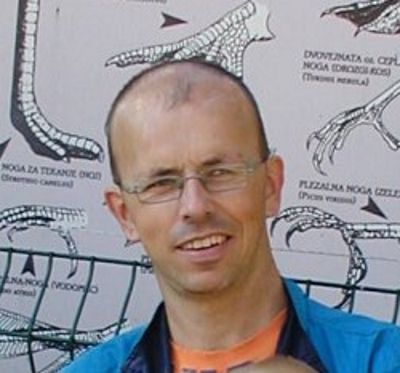
Robert Posl
And so you moved back?
Yes, and after moving from South Africa to Slovenia, to Europe, I felt that I was now properly introduced to history. Moving from a country which has bareky any history compared to that of mainland Europe. Most of the countries in Europe have also put significant efforts into maintaining and restoring their cultural heritage, so now I could see and even touch it, compared to only reading about it. Slovenia is thus dotted with numerous buildings and monuments, which clearly express its history. Especially the countless number of memorials and plaques reminding us of the Second World War.
One thing I heard about a lot about the Partisans. The most common thing I’d hear was how difficult it was and how they lived in poverty and in hunger, with ragged clothes and inadequate equipment. My reaction was obvious, “who would want anything like that? So unpleasant!”
So that’s how you came to translate this story?
Yes and no, because there’s more of a family connection than just an interest in history. Some years ago my wife’s uncle, Alojz Voler, published his autobiography and experiences during the war, when he served with the Partisans. Alojz kept the publication quite quiet, mainly only sharing it with relatives and acquaintances. I paged through it a couple of times, reading some sections and admiring the photos.
Then in the spring of 2017, a car with foreign registration plates stopped in front of his house. They were from England, except for the translator who was with them. They were looking for a man who was involved in a remarkable event during The Second World War, “The Flight of the Crow”. A team were in Slovenia making a movie about this great event, something most people didn’t even know happened.
When I learnt more and that Alojz was involved in it, I right away suggested that his autobiography be translated into English and to include the details of this event. The more I thought about it, the more I saw the need for this to be done.
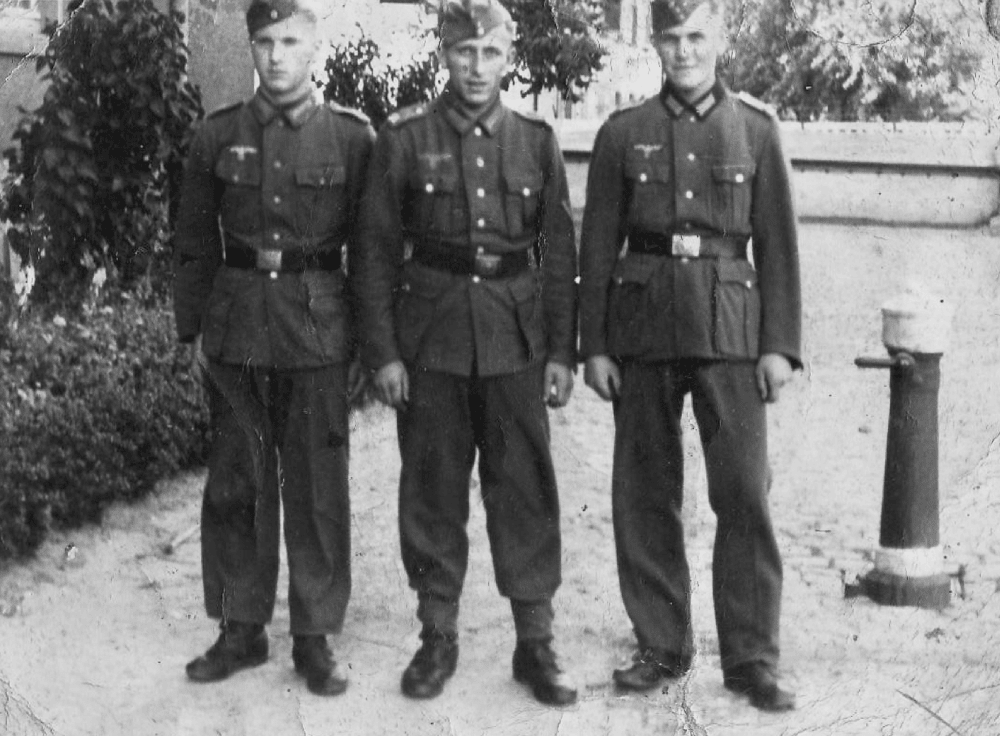
Alojz Voler, with German recruits. He served in the German army for 14 months before he managed to desert them and return to Slovenia, where he then joined the partisans.
What was that like?
I got to know more of the details and specifics about Alojz and the life he lived. He was born in 1925 on a farm in the Savinja Valley in Northern Slovenia. Not only was I getting to know him, but I was also getting to know what it was like living in that period. The onset of the Second World War and the influence of the aggressors, which was long felt before the conflict even started.
The Second World War was for Yugoslavia more than just the invasion and engagements with German forces. A significant part of it was the tension and politics within the country itself. Already in primary school, Alojz would be tolfd negatuve things about the Partisans, and how they lived in hunger and poverty. Surprisingly, it was allo very to what I so often heard when I moved to Slovenia.
For Alojz to follow his heart was a journey in its self, and to join the Partisans was an almost unimaginable and treacherous step to make. I admire how Alojz expresses this idea: To go into resistance with almost bare hands, against the most elite forces of the world at that time, was an almost fantasy. But it was no fantasy, it was the cruel reality.
Starting with this translation at first only fed fuel to the fire of my curiosity. What kind of person, and why, would want to be part of the Partisans? But by following Alojz’s life throughout his book, my questions were answered.

Alojz on the right, with other members of the KNOJ (Korpus narodne obrambe Jugoslavije). Photo taken after the war ended.
The book obviously has many other stories, but how was Aljoz involved in the “Escape of the Crow”?
The battalion Alojz was in was based to the west of Maribor, nearby the Ožbalt work camp. Some of the Partisans were chosen to escort a group of six POWs, including Ralph Churches, away from the area ASAP. The next day they returned and managed to free the rest of the captives, and it was then that Alojz met and helped them to safety and away from Ožbalt before the Germans intensified their search for the prisoners.
Here is a photo, which is also on the cover of A Hundred Miles as the Crow Flies. The guy on the left, almost out of the picture is Franjo Gruden, the leader of the escort team. Alojz was at the back to make sure nobody fell behind.
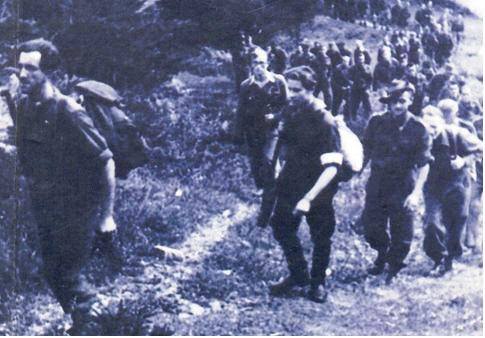
And here is a map I made for the book. You can see where they went, up to Gornji Grad, then another group of partisan soldiers took over to escort them further.

And what you have learned from the book?
For me the most important things about working on this project are being able to share a part of history, but more than that, it’s about giving Alojz that feeling of pride. At 94 years old it’s quite something that his story is finally being told, and that he’s the one to tell it. And so I hope that more people will hear about him and what he did during the war.
While doing the translation, and still after, people would ask me: “Who is paying for this? How much are you being paid?” My answer – Alojz has paid me; with the truths and experiences from his heart, as seen by an ordinary, humble man. And with the knowledge, that I can now confidently say, “I know who and what the partisans really were”.

Alojz Voler, Niel Churches & Monty Halls, Spring 2017
If you’d like to read Alojz’s story, Through the Eyes of a Partisan Soldier, then you can pick up a copy, in both paper and digital forms, from Amazon, while all our stories on World War Two are here
STA, 22 March 2019 - Threats by dozens of general practitioners around the country to quit in the face of a recent decision to increase the number of patients GPs are expected to cover have been making headlines in recent days. Matters seem to be spiralling out of control, as medical students have also been showing no interest to pursue a career in general practice.
While tensions over increasing red tape for GPs and their general workload have been mounting for years, the situation seems to have escalated as a result of the financing and organisational plan for public healthcare in 2019.
The plan, put forward by healthcare purse manager ZZZS and confirmed by the government, raises the permitted number of patients per GP. The increase also affects health centres that have been performing above that national average, which has been scrapped as a reference point.
More Slovenian doctors start to protest
The first to protest were 21 doctors in Kranj, who already stopped accepting new patients in February. They also addressed a letter to Samo Fakin, who in the meantime resigned as health minister due to ill health, in which they threatened to quit by the end of March.
All of the 15 GPs at the Celje Health Centre issued a similar threat earlier this week, while three doctors at the Nazarje Health Centre have already resigned.
Moreover, on Thursday doctors at the Ajdovščina Health Centre, which has seen a number of retirements in the recent period, announced they would no longer perform overtime work.
Doctors' organisations are demanding solutions that will allow GPs to do their job in line with professional standards. They say that the recommended patient index is 1,500, that the currently valid ceiling is 1,895, while the actual Slovenian average stands at 2,406.
However, the ZZZS argued that enforcing the ceiling would mean 325,000 people in Slovenia remaining without primary healthcare.
A threat to the constitutional right to healthcare
"Every stakeholder in the system shares some responsibility for solving this problem together. It however cannot be solved in the way proposed by some doctors, by starting to reject patients at 1,895, since this would even violate the constitutional right to healthcare," the ZZZS said.
Solutions highlighted by the ZZZS include appropriate education policy planning, meaning securing enough GPs, and a reduction of administrative burdens. It is also looking for ways to secure more funding.
"The management of health centres also have a number of tools at their disposal and can above all use reallocation to secure a more equal distribution of burdens among doctors," the ZZZS wrote.
There are currently 950 GPs in Slovenia along with 315 GP trainees and according to February data, the workload of 42% or of 595 family and children's doctors did not exceed the Slovenian average.
The Health Ministry, which is being run temporarily by Prime Minister Miro Šarec since Fakin's resignation, says it is drawing up measures that will resolve things in a systemic manner.
It announced fewer administrative tasks, a new financial model for primary healthcare that will be stimulative, and a call for applications for 80 to 90 GP speciality training spots in this year.
Healthcare in Slovenia faces growing problems
The problem however is that interest for a career in general practice has been very modest. Only 13 application were filed for 64 spots made available in a call last spring and eight in the autumn call that offered 60 spots.
What is more, health centres did not manage to find new GP staff even though additional funding had been secured for the purpose.
The head of the family doctors' trade union Praktikum, Igor Muževič proposed the impasse could be bridged with the inclusion of foreign doctors. He however added that no dialogue exists between the union and decision makers.
The situation was meant to be discussed today by the parliamentary Healthcare Committee, but the session was cancelled because it was not certain the representatives of the Health Ministry would be able to attend.
All our stories on healthcare in Slovenia can be found here
STA, 22 March 2019 - Slovenia's sole seaport in Koper is not concerned about the prospect of Chinese investments in the port of Trieste, its biggest rival among north Adriatic ports. It says there is plenty of scope for growth of all ports in the region.
"We've always emphasised our support for development projects of all ports in the region," port operator Luka Koper told the STA, noting that investments were the only way north Adriatic ports can compete with ports in North Europe.
The company quoted a study commissioned by the North Adriatic Port Association showing that ports from Ravenna to Rijeka have a combined potential to transship six million container units per year; in 2018 they handled 2.8 million units.
It is precisely in container transshipments that Trieste poses the biggest threat to Koper with the help of state-sponsored Chinese investors.
Koper handled 988,000 container units last year to Trieste's 725,000, but Trieste's volume was up almost a fifth over the year before while Koper registered only 8% growth in container shipments.
Overall, Trieste and the adjacent Monfalcone handled 67 million tonnes of cargo while Koper handled 24 million tonnes, both figures records for the respective ports.
Not only is it unfazed by the prospect of even stronger competition from Trieste, Luka Koper notes that all ports in the region have the same problem: poor rail connections inland.
Koper has a single track connecting it to the national rail network, Trieste faces bottlenecks within the port itself, and in Croatia's Rijeka the tracks still cut through the city.
"Rather than being concerned about what neighbouring ports are doing, it is important that Koper and Slovenia realize plans that we have adopted," the company said about the coming construction of a new track connecting the port with the inland hub Divača.
Construction of the EUR 1bn-plus track covering a distance of 27 kilometres has already started - contractors are currently building 20 kilometres of access roads - but the project is expected to take many years due to the difficult karst terrain.
Concern about Chinese plans have been raised in Slovenian media after it was announced that during Chinese President Xi Jinping's ongoing visit to Italy a memorandum of understanding on Chinese infrastructure investments would be signed.
According to plans, one of the pillar of the investment plan would be to strengthen Trieste's rail connections inland, which some see as a serious threat to Koper's competitive position.
Elen Tvrdy, the dean of the Koper Faculty of Maritime Studies and Transport, told the STA Trieste's plans required not only that the new Koper-Divača was built, but also that the port itself Koper continued investing.
"We must always be concerned about loss of market or partners. Koper must continue with investments, this is the only way it will remain competitive, regardless of whether or not the Chinese come to Trieste.
She noted that the Chinese were looking for a foothold in north Adriatic because of short transport routes to Central Europe. North Adriatic has geographic advantages, but good rail connections are critical, she said.
All our stories on logistics in Slovenia are here
STA, 22 March 2019 - Janez Janša has announced that his Democratic Party (SDS) will ask the Constitutional Court to review the supplementary budget for the year arguing that it poses a major risk for Slovenia.
Making the announcement via his Twitter profile, Janša said the revised 2019 budget is "evidently unconstitutional" and "structurally the worst since 2009 and 2010".
"It dangerously exposes Slovenia to great risk at a time of an economic downturn. We will demand a constitutional review," Janša tweeted, without disclosing any further details.
Sprejeti rebalans proračuna 2019 je evidentno protiustaven. Strukturno pa najslabši po letih 2009 in 2010. Slovenijo nevarno izpostavlja velikemu tveganju v času ohlajanja gospodarske rasti.
— Janez Janša (@JJansaSDS) March 22, 2019
Zahtevali bomo ustavno presojo. #proračun #fiskalnopravilo #ustavnapresoja
The revised budget, passed by the lower chamber in a revote on Wednesday following the upper chamber's veto, projects 6.2% higher revenue than in the original budget, at EUR 10.35bn, and 4.8% higher expenditure, at EUR 10.16bn. The surplus is projected to stand at EUR 193.6m.
The Fiscal Council issued a negative opinion on the budget due to excessive expenditure and a lack of reform measures. The general government expenditure for the year is budgeted EUR 1.13bn above last year's, while the fiscal rule law effectively caps the increase at EUR 870m.
Responding to Janša's tweet, Finance Minister Andrej Bertoncelj repeated his position that the budget was optimal given the circumstances, noting that the budget surplus was quite high at 0.6% of GDP.
He said that there was no need to beat the drum, something that he said was a view voiced by the Fiscal Council's chair Davorin Kračun.
"After the long years in which we generated a deficit of 24 billion euro, we have a budget surplus this year. We are also actively reducing public debt, and we are even the most successful country in the eurozone in doing so," the minister said.
He conceded that Slovenia had a slight structural deficit, which he said the government planned to tackle with structural measures over the next three years.
"If you have a surplus, if you are reducing debt and implementing structural measures and reforms, why would you need to beat the drum," Beroncelj wondered.
"Things are perfectly under control," said Prime Minister Marjan Šarec, commenting from Brussels, arguing that Janša was trying "to create political turmoil again", which he said made no sense.
A constitutional review as proposed by Janša may be initialled by the National Assembly or a third of deputies, the National Council or the government, and depending on the substance matter also by the human rights ombudsman, the information commissioner, the central bank and the Court of Audit.
Other qualified petitioners are the state prosecutor general, the representative body of a local community or a representative association of local communities or a representative trade union.
The petitioners cannot ask for a review of regulations or general acts that they have adopted themselves.
If the SDS was to file the request as a group of one third of deputies, it would need the support of at least one more opposition party, considering the party has 25 seats in the 90-member assembly.
Apart from the SDS, New Slovenia (NSi) also voted against the supplementary budget, while the National Party voted in favour.
In the parliamentary debate on the budget, the SDS noted that the government failed to heed the warnings by the Fiscal Council that expenditure was excessive, and that the document did not foresee reforms.
Commenting on the proposal for a constitutional review, the NSi said that it had already warned of the supplementary budget's unconstitutionality in parliament.
The party tweeted that it would discuss potential measures to deal with the unconstitutional situation with legal experts next week and decide on further steps.
SNS leader Zmago Jelinčič told the STA the party would not supply its signatures in support of a constitutional review of the budget.
"This is Janša's solo campaign, we haven't discussed that," said Jelinčič, adding that it was Janša's attempt to topple the government, which he said was not good.
According to constitutional jurist Lojze Ude, it is not very likely that the Constitutional Court would find the supplementary budget in breach of the constitution.
He does not think the budget is violating the fiscal rule, enshrined in Article 148 of the constitution, which provides that general government revenue and expenditure must be balanced over the medium term.
Jurist Matej Avbelj of the European Faculty of Law disagrees with the view. He told the Odmevi news show on TV Slovenija last night that the supplementary budget contravened the fiscal rule and thus the constitution.
He said that the general government expenditure exceeded the scope defined by the fiscal rule, while it also constituted a violation of Slovenia's commitments under the EU fiscal compact.
Fiscal Council chair Kračun told Odmevi that the supplementary budget did not comply with the article of the fiscal rule law which prescribed the formula for securing a mid-term fiscal balance, but that it was impossible to assume based on one year alone whether the government was in breach of the constitution.
He did say though that the risk of a breach of the constitutional provision was increasing. Ude told the STA today that he agreed with Kračun.
You can keep up with Slovenian politics and find all our related stories here
STA, 22 March 2017 – NKBM (Nova Kreditna Banka Maribor), Slovenia's second largest bank, posted a group net profit of EUR 72.5m for 2018, a year-on-year increase of 50%, shows the audited annual report released on Friday.
The bank recorded a substantial increase in net interest revenue, which was up 32% to EUR 109.6m, whereas non-interest revenue declined marginally to EUR 59.3m.
NKBM also booked substantial revenue, EUR 16.5m, from the cancellation of write-downs and provisions, an indication of an improving credit portfolio.
The share of non-performing loans declined by over four percentage points at group level, the bank said in a press release.
The bank remains well capitalised, with the common equity tier 1 capital ratio, a key benchmark of capital adequacy, remaining roughly level at 20.13%.
Total assets rose marginally to just under EUR 5bn.
Keep up with all the business news in Slovenia here
STA, 22 March 2019 - The government macroeconomic think-thank has estimated that the direct impact of a no-deal Brexit on Slovenia would be small, while the indirect impact through the countries with which Slovenia does most of its trade would be greater but also harder to measure.
The Institute of Macroeconomic Analysis and Development (IMAD – Urad RS za makroekonomske analize in razvoj) has found based on various studies that the long-term effect of a no-deal Brexit on Slovenia would be between -0.2% and 1% of gross domestic product (GDP).
Meanwhile, the impact of an orderly exit of the UK from the EU would be smaller, estimated at between -0.1% and -0.25% of the country's GDP.
This would hold true in the case of the confirmation of the current Brexit agreement, which envisages the UK remaining part of the customs union, IMAD said in its latest publication on macroeconomic trends.
"Introduction of customs duties would decrease the volume of bilateral trade between Slovenia and the United Kingdom, with the electrical, automotive, pharmaceutical and metal industries suffering the largest negative effect."
According to the think-tank, also to be somewhat affected would be exports of services, in particular tourism and transport.
Since the direct connection of the Slovenian and British economies is relatively small (Slovenia generates 1.9% of its exports in the UK), the direct negative effect on exports and GDP would be small.
An indirect effect would be somewhat bigger due to Slovenia's trade connections with Germany and France, which are major trade partners of the UK.
All our stories about Brexit are here
STA, 22 March 2019 - Slovenia's top science and research institution, the Jožef Stefan Institute (IJS), will mark its 70th anniversary over the course of the coming week, having started with an open day last Saturday, March 23. Between Monday and Friday, top researchers from across the globe will speak in Ljubljana about their work at the cutting edge of science.
Perhaps the top event of the coming week will be a talk by top robotics expert Vilay Kumar, the dean of Penn Engineering, a graduate school at the University of Pennsylvania.
Taking place as part of the main ceremony marking the IJS's 70th anniversary on Wednesday, Kumar's talk about flying robots will be "very interesting visually," IJS head Jadran Lenarčič has told the STA.
The anniversary week will start with an open day tomorrow, allowing the public to take one of several tours of the institute's laboratories.
On Monday, a day after the actual birthday of the late Jožef Stefan (1835-1893), considered one of the top Slovenian scientists, the 27th annual Jožef Stefan Days will officially open.
Zdenka Badovinac, the director of Modern Galerija, will deliver a talk ahead of the opening of an exhibition titled Irwin: NSK Guards and Processions.
The next day, Bart De Moor of KU Leuven will talk about the role of new technologies and data science in biology in the future, while Rosario Rizzuto, a rector at the University of Padua, will talk about calcium signalling in cells.
After the main ceremony on Wednesday, Thursday will feature a talk by Jean-Claude André, the inventor of 3D printing, while the Jožef Stefan Days will wrap up with a talk by Geoff Webb of Monash University, a top data scientist.
The institute will also name the winner of an annual competition for young researchers. This year, the winner will get between EUR 300,000 and 350,000 to set up their own lab.
Yo ucan see more details of the programme here, while all our stories on research in Slovenia are here
STA, 24 March 2019 - Overall World Cup winner Ryoyu Kobayashi of Japan won the final event of the World Cup season in Planica on Sunday after equalising the hill record in the first series. Domen Prevc of Slovenia finished second ahead of Friday's winner, the German Markus Eisenbichler.
Kobayashi managed to equalise the giant hill record of 252 metres in the first series, just a metre and a half below the world record, and cemented his 13th season win with 230.5 metres to beat Prevc, who flew 239.5 and 222.4 metres, by almost 25 points.
Eisenbichler in third was just a point and a half shy of Prevc with jumps of 227 and 235 metres.
"I feel wonderful, the emotions are out in full force," Prevc said about his performance in front of the home crowd. "I knew I'd be on the podium, but I did not know I'd take the lead," he said.
Slovenia had two more top-ten finishes, as Timi Zajc grabbed fifth place and Anže Semenič was ninth with a personal best of 241 metres.
All our stories on Planica, past and present, are here
* Results: 1. Ryoyu Kobayashi (Jap) 464,9 points (252,0/230,5 metres) 2. Domen Prevc (Slo) 444,0 (239,5/222,5) 3. Markus Eisenbichler (Ger) 442,5 (227,0/235,0) 4. Piotr Žyla (Pol) 438,6 (248,0/222,0) 5. Timi Zajc (Slo) 425,4 (231,5/229,5) 6. Dawid Kubacki (Pol) 424,8 (229,5/234,0) 7. Karl Geiger (Nem) 422,8 (238,5/228,0) 8. Johann Andre Forfang (Nor) 416,2 (225,0/223,5) 9. Anže Semenič (Slo) 413,8 (241,0/224,0) 10. Jevgenij Klimov (Rus) 411,7 (233,0/221,5) ... 19. Peter Prevc (Slo) 381,0 (221,5/204,5) 29. Anže Lanišek (SLO) 317,8 (195,5/201,5) ... - Final World Cup standings: 1. Ryoyu Kobayashi (Jap) 2085 2. Stefan Kraft (Aut) 1349 3. Kamil Stoch (Pol) 1288 4. Piotr Žyla (Pol) 1131 5. Dawid Kubacki (Pol) 988 6. Robert Johansson (Nor) 974 7. Markus Eisenbichler (Nem) 937 8. Johann Andre Forfang (Nor) 892 9. Timi Zajc (Slo) 833 10. Karl Geiger (Nem) 765 ... 13. Domen Prevc (Slo) 542 28. Anže Semenič (Slo) 203 29. Peter Prevc (Slo) 179 30. Anže Lanišek (Slo) 177
STA, 23 March 2019 - Robert Kranjec, one of the best Slovenian ski jumpers of all time, bid an emotional farewell to his fans after a career spanning 21 years with one final flight down the Planica ski-flying hill on Saturday.
Appearing in 325 Ski Jumping World Cup events, Kranjec tallied 15 victories and a total of 27 podium finishes, team events included, since his debut in Trondheim in 1998.
He was part of the team that won bronze at the Salt Lake City Olympic Games in 2002 and ten years later became the world champion in ski flying, his flagship discipline, with a jump of 244 metres.
Indeed, it was his exceptionally good feeling for flying which earned him the moniker the Flying Carniolan (Leteči Kranjec), something that he demonstrated once again today.
Having become the first jumper to cross the 200-metre mark 200 times at Planica last year, Kranjec improved this special record today, landing at 213.5 metres, in his 212nd over the 200-metre flight.
In his final feat he was cheered on by a crowd of 21,200 gathered in the Alpine valley offered referred to as the "cradle" of the sport.
Among those who came to pay him tribute was Primož Roglič, his former team mate who went on to become Slovenia's cycling sensation. He presented Kranjec with a yellow jersey.
Kranjec, reaching the outrun of the ski-flying hill after the first series of today's team event, which saw Slovenia finish third, sent items of his gear flying among the fans as keepsakes before being overwhelmed by a wave of hugs and cheers.
"Thanks to the fans! Thank you for cheering me on for every flight and thank you for supporting the team," the 37-year-old said in an emotional goodbye.
His first individual World Cup victory in Kuusamo in 2005 was his sole individual win in ski jumping, the remaining six being achieved on the ski-flying hills of Planica, Vikersund and Kulm.
Apart from winning the 2012 ski-flying championship, he won two more team world championship medals, the team ski-jumping bronze in Oslo in 2011 and bronze in the ski-flying team event in Vikersund a year later.
This was his last medal in such a major competition. What followed was a difficult period in which he struggled with injury.
First he had difficulties with his elbow, but he still finished top of the podium two times in the 2015/16 season. When he appeared to be coming back to the top, he suffered a bad knee injury just before the next season, followed by surgery and a lengthy recovery.
After struggling through last year's season, he considering retiring, but decided to give it one more try. It was his back that gave him problems this time, so he decided to call it quits.
"I've decided this will be my last journey to Planica, because I will end by career in Planica," Kranjec said ahead of today's event saying that he made the decision in January.
This week includes Friday, March 29, and at 11pm that day the UK might finally commit Brexit, of the no deal variety, which could provide all the weekend entertainment some of you need. Here’s a summary of the current situation and how we got here, with bad language.
Metal fans will want to pay attention to the month-long Orto Fest that starts this week end continues to the end of April, just head down to the Live Music section and check out Orto bar. And a reminder that Open Kitchen is back, bringing al fresco dining to the heart of the city every Friday – read our interview with the co-founder here, with similar events planned for other towns around the country. It may be too late to buy a ticket for SILA’s Spring Soiree, which takes place next Saturday (30th), but you can always try (learn more here), and if you don’t know what SILA is, and you’re a woman who lives in or near Ljubljana, then learn more here. Looking a little further ahead, to April 8, Hanieh Vidmar is having a speaker training event in Celica – you can read our interview with her here. If there's something you want to promote in a future edition of What's on in Ljubljana please get in touch with me at flanner(at)total-slovenia-news.com, or trying and find me on Facebook.
If you're not in town for the week of this guide (March 25 - 31, 2019) then you can see all the editions here, and you can enhance your stay in the city and impress or annoy friends and companions by learning some obscure facts about the city here, and the Castle here. Last week, March 21, was the 70th birthday of Ljubljana-native and "rock star philosopher" Slavoj Žižek, so we put together 70 quotes from the man himself - get educated here.
As ever, clicking on the venue names in the list below should get you more details with regard to the time, price and location, as well as other events on at this place in whatever week you're here. Finally, if there's something you want to promote in a future edition of What's on in Ljubljana please get in touch with me at flanner(at)total-slovenia-news.com or try and find me on facebook.
- Cinemas and films
- Clubbing
- Live music
- Opera, theatre and dance
- Harm reduction and drug testing
- Things to do with children
- LGBT+ Ljubljana
- Ljubljana Castle
- Museums and galleries
- Other things to do in Ljubljana
- Daytrips
- Getting around & miscellaneous
Cinemas and films
You can read about all the cinemas in town here, while a selection of what’s playing this week is below, and note that kids' movies tend to be shown in dubbed versions, while non-English language movies for older viewers will have Slovenian subtitles. Parents should also pay attention to Kinobalon, which is Kinodvor's regular weekend series of film screenings and events for children, from babies on up, with special parent/child events, "first time in a cinema" screenings, and babysitting. Learn more about it here, and see the current schedule here.
Kinodvor – The arts cinema not far from the train station is showing, among other features, Ne bom več luzerka to be shown with English subtitles on Sunday, March 31 and Tuesday April 2, Putin’s Witnesses, Vision, Minding the Gap, and, starting Saturday, Dumbo.
Kinoteka – This revival cinema isn’t far from Kinodvor, at the train station end of Miklošičeva, is showing, among other titles, Rois et reine, Les rivières pourpres, Crouching Tiger Hidden Dragon (Chinese, with Slovene subs), Broken Flowers and ET.
Kino Bežigrad - Out here you can enjoy Captain Marvel or Us.
Kolosej - The multiplex out at BTC City Mall is playing all the big titles, but note that there are far more movies than screens, so some of the older ones may only be playing once or twice a week. Click on the theatre name to see the actual times before making a date. New this week are Dumbo, Ne bom več luzerka, and Storm Boy. Continuing are Us, Creed II , Yao, Captain Marvel (2D and 3D), Colette, Posljednji Srbin u Hrvatskoj, How to Train Your Dragon: The Hidden World, Green Book, Ralph Breaks the Internet: Wreck-It Ralph 2 (dubbed), A Star is Born, Bohemian Rhapsody, Escape Room, Lego Film 2, Alita: Battle Angel (2D and 3D), Qu'est-ce qu'on a encore fait au bon Dieu?, Mia et le lion blanc, Happy Death Day 2U, Instant Family, a dubbed version of Liliane Susewind, Replicas, Izbrisana, and a dubbed version of The Queen’s Corgi.
Komuna – The cinema in a basement behind Nama department store is showing Qu'est-ce qu'on a encore fait au bon Dieu?, Green Book, Ne bom več luzerka and Colette.
Clubbing
Compared to some European capitals it can seem that nightlife in Ljubljana ends rather early, especially along the river, but there are still bars that stay open late and clubs were you can dance until dawn, and perhaps the best place to stumble across something interesting is the legendary Metelkova. Be aware it's a grungy kind of place and not for all tastes, but also that there's considerable variety to found within the various clubs there, from death metal to electropop, gay cabaret to art noise. You can read "the rules" of the place here. And if you're curious about how the place started then read our story, and look at some pictures, about last year's 25th anniversary.
Božidar - Friday, March 29th, there’s Mladost: Borut Cvajner & Disrupted Project.
Channel Zero – Friday there’s techno from KFTØ w. Kaiser.
Cvetličarna – Friday there’s an RnB Reunion all-nighter, with DJs Sami Biyeh, Em Bee and Sheko.
Klub Cirkus – Friday there’s TRIP ft. KOSTA Radman & MC DEY, while Saturday it’s TUTTI Frutti: 90s & 00s Hits.
Klub K4 – Friday the klub 4 kool kids has K4DNB w/ Changing Faces (SK) [Hospital, RAM], a drum’n’bass event. Saturday you can then hit the dancefloor with Trillity x KROM ft Ledeni playing trap.
Klub Gromka – Friday there’s Holomondo, an “indie pop” party promoted with the following text, as translated by Google: “Indie pop rock electro disco trap, al some. Grimes is now nu metal, Zala and Gasper are on Eurosong, Merriweather Post Pavillion is ten years old. Is this a legacy party? What else is to be honest? What else is it to do? Water skis on the legs jumps over the shark. Old pieces, new treasures. Old feelings, a new party.”
Live music
Cankerjev dom – Tuesday evening there’s a show from Victoria Hanna, while on Saturday (03/30) it’s the turn of Nina Badrić. Thursday and Friday Dmitrij Sitkovecki is with the orchestra, playing Tchaikovsky, Stravinsky and Prokofiev., while on Saturday he back with Beethoven and Mendelssohn.
Channel Zero – Wednesday you can witness Crypt Trip (Psychedelic, Southern rock / USA).
Gala Hala – Friday there’s live rap and hip hop with Mrigz ‘n’ Ghet presenting their new album, along with DJ support from SunnySun and Toljo.
Kino Šiška – Wednesday is Piano Day, and at this venue you can celebrate with Hania Rani. Thursday there are two trios playing here, with surf pop from Dives and indie rock from The Attic.
Klub Gromka – Thursday there’s live jazz from Olfamož, Youri Defrance, and Zu, in an event marking 50 years of Radio Student.
Ljubljana Castle – Friday is jazz night, and this week it’s the Pickpocket Swingers.
Orto Bar – The home of metal starts Orto Fest, which runs from March 28 to April 27. The full schedule can be found by clicking the venue name, while this Wednesday there’s Septicflesh, Krisiun, Diabolical, and Xaon; Thursday it’s Goran Bare & Majke; Friday sees Rudhen, Pyroxene, and Old Bridge Cartel; the same night also sees Higher On Maiden, an Iron Maiden tribute band; Saturday the stage is owned by Gonoba, Paragoria, and Licence to Hate.
Pinelina dnevna soba – Friday evening you can hear Dan Stuart with Don Antonio.
Slovenska filharmonija – Wednesday a student choir will be singing here to mark 100 years of Ljubljana University – they were singing in the street in Trubarjeva the other night and sounded very good.
Opera, theatre and dance
Gledališče IGLU - IGLU Theatre – Saturday night this group is usually putting on an English improv show somewhere in town, but it’s generally promoted after this is written, so check the Facebook before putting on your shoes.
Mini Teater Ljubljana – The English schedule of varied performances for the month is here.
SNG Opera and Ballet - Tuesday and Wednesday evening there’s the Slovenian operetta Gorenjski slavček, by Anton Foerster.
Pocket Teater Studio – One performance of Carlos Pascual’s new play, Border Love, are scheduled this week, on Tuesday, while Friday 29th sees another show in the Noches de Tablao - Flamenko: Mediteran series of live flamenco music and dance evenings, with wine. Saturday then has Sounds of Brazil with Denise Dantas Quartet. Note that the number of seats is very limited, and thus you should make a reservation via This email address is being protected from spambots. You need JavaScript enabled to view it. or 070 325 522. The price of ticket is 20€ or 15€ for students, and includes wine with the music shows, tequila with Border Love.
Harm reduction and drug testing
Drogart is an organization that aims to minimise harm on the party scene, and offers drug-testing services and reports on their webpage. It’s in Slovene, but you can Google translate it or work things out yourself, and our story on the group is here. You can find the latest warnings on fake drugs and high strength pills and powders (in Slovene) here. However, be aware that all the usual drugs are illegal in Slovenia.
CBD is legal, though, and our retailer of choice can be found on Trubarjeva cesta - read more about Sena Flora here.

Things to do with children
You can find our Top 12 list of things to do with kids in Ljubljana here. If want to read more about the philosophy behind the wonderful House of Experiments look here, while our trip to the Museum of Illusions is documented here, and there’s always riverside walks, pizza and ice cream. With regard to the latter, take a look at our guide to six places that serve good ice cream in winter.
Mini Teater Ljubljana – The season sees a lot of puppet performances for children, in Slovene, at this theatre not far from Križanke. The English schedule for the month is here.
Ljubljana Puppet Theatre - The puppet theatre near the Central Market and next to the Castle funicular has a full programme or shows, for children and adults, with the schedule here.
LGBT+ Ljubljana
If you want to learn more about Ljubljana Pride, then take a look at our interview with its president here. If you're looking for more general links on "gay Slovenia", including a history of the scene and various projects, then you can find that here, while our stories about the community can be found here.
Klub Monokel – This lesbian bar in Metelkova is open every Friday
Klub Tiffany – And the gay bar next door is also open on Fridays, while every Monday until June 2019 there's tango at 18:00. This week, on Tuesday, there’s Rok Kravanja: *arija*omagaj, 20:00 to 22:00, a theatrical performance. You can see some of the NSFW show here. Saturday night there’s Supersonique Electronique – Classique, with DJs m00sh, Naj, and Duki, with go-go dancers.
Pritličje – This seems to be the only "always open" LGBT-friendly cafe / bar / events space in town, and perhaps the country, so it's a good thing it's such a good one, open from morning to night, and with fliers and posters letting you know what's happening outside the narrow confines of, say, a general interest online what's on... guide.
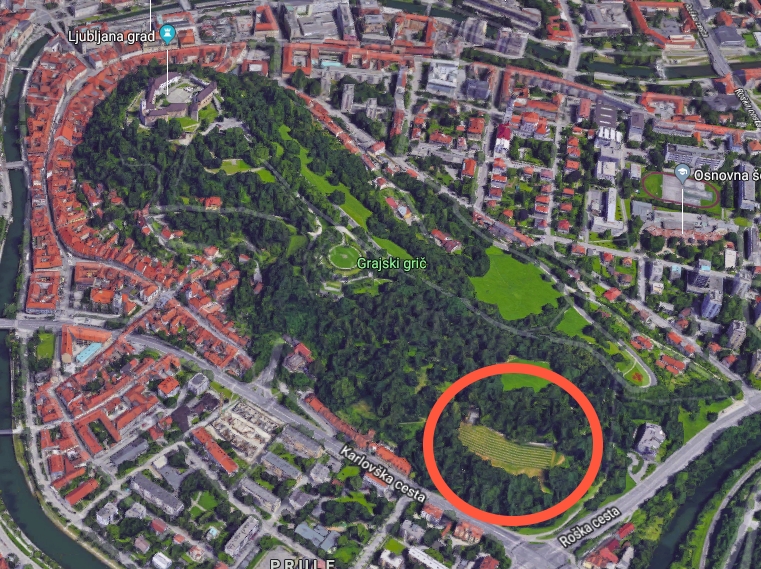
Screenshot from Google Maps, showing the location of the Castle vineyard
Ljubljana Castle
The city’s main attraction is said to be the top tourist draw in the country overall, and to my mind it earns a spot near the top just for the history and views. But beyond that the current owners, the City of Ljubljana, have laid out a varied, interesting and enjoyable programme of events, one that rewards regular revisits.
I try and get up there every Saturday morning to clear my head and move my feet on the trails, and never tire of that end of the hill. At the other end, where the Castle sits, there’s a lot more than fresh air on offer. There are guided tours, restaurants, a café, Castle museum, puppet museum, a Watchtower you can climb to the highest point in the city, art shows, dances, live music, movies under the stars, festival days and more – enough to reward multiple trips up the hill through the year. All of these activities and events can be found on the Castle website, while on TSN you can see “25 things to know about Ljubljana Castle” here, and “Ten Ways to Enjoy Ljubljana Castle” here.
Museums and galleries
Most public galleries and museums are closed on Mondays, although not the National Museum, and - as noted at the start
Plečnik's desk. Photo: JL Flanner
Plečnik’s House is worth a visit if you want to learn more about the architect who gave Ljubljana much of its character, and it's also in a really nice part of town, Trnovo, just a short walk or cycle upriver. Read about our guided tour here.
Balassi Institute – The Hungarian culture centre has an exhibition entitled “Encounters in Visual Art” introduces works of selected visual artists, painters and sculptors, who define today's art scene in Hungary and Slovenia, as promoted with the image below. Free to enter, this venue is next to a Spar and Hofer, and not far from Dragon Bridge, and always has something interesting going on. Learn more here.
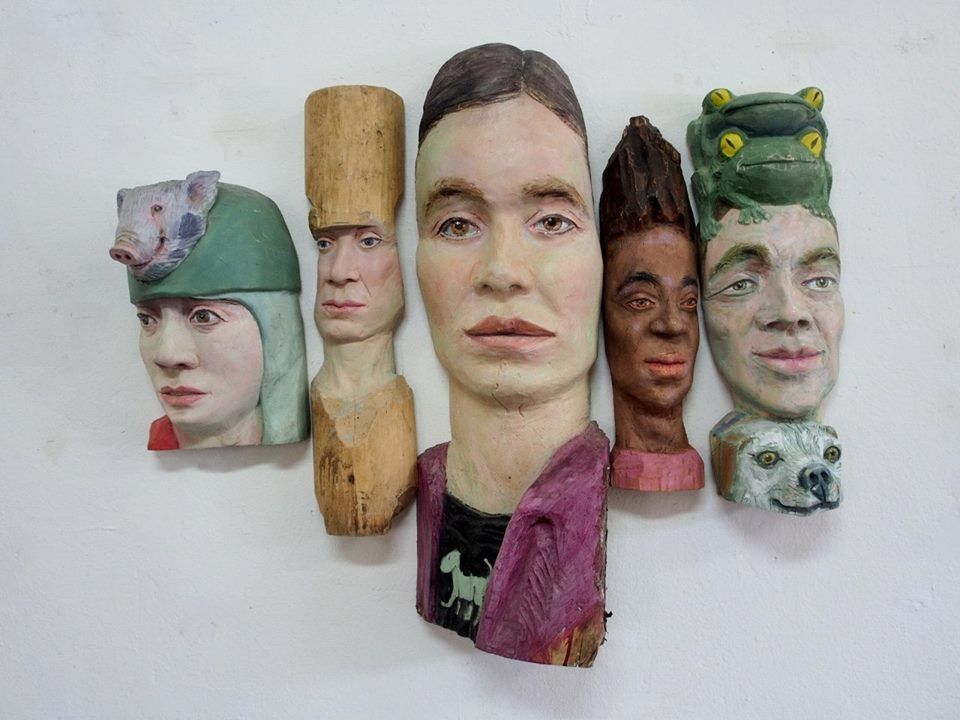
Cankerjev dom – Showing until the end of March is a selection of specimens (in Slovene, English and other languages) from The Newspaper Museum, while there are also some architectural models and plans on display.
City Museum – The Museum in French Revolution Square an interesting permanent exhibition on the history of Ljubljana, from prehistoric times to the present day, with many artefacts, models and so on that bring the story alive.You can read about my visit here.
The Faces of Ljubljana in the City Museum. Photo: JL Flanner
International Centre of Graphic Arts – Starting March 22 and running until May 19 is Photographic Images and Matter: Japanese Prints of the 1970s and Japan, Yugoslavia and the Biennial of Graphic Arts: Documents of Collaboration. One of the images promoting the show is shown below.
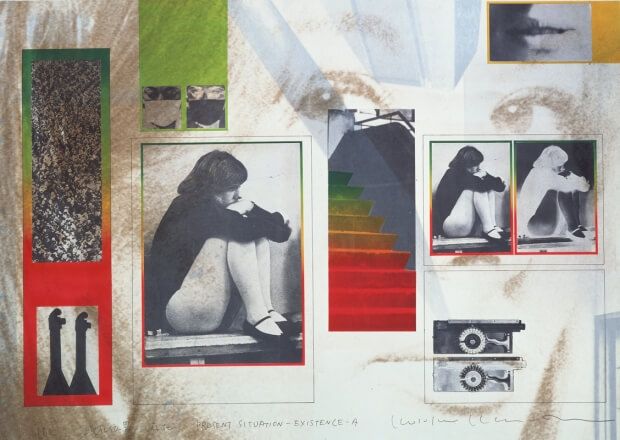
Kosuke Kimura: Present Situation – Existence A, colour and silkscreen, 1971.
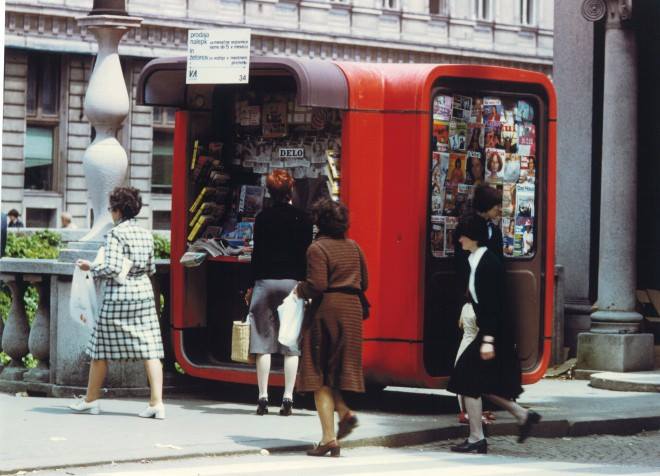
A K67 by the Triple Bridge, in Ljubljana. Unknown photographer
MAO – The Museum of Architecture and Design has much of what you'd expect, along with some temporary shows and a good cafe. Until April 5 there's an exhibition on the K67 Kiosk, an icon of Slovene design that you can learn more about here, while until May 19 there's Tendencies: Architecture and Urban Planning in Celje, 1955–1985.

Rafikun Nabi: Poet, 1980, print, 96.5 x 110 cm. Courtesy of the Contemporary Art Center of Montenegro. On display at the Metelova branch of the Moderna galerija
Moderna galerija – The main branch of this gallery, to be found near the entrance to Tivoli Park, has a good collection of modern art, as well a nice café in the basement. Running until March 31 is a major show on young Slovenian painters, Time Without Innocence – Recent Painting in Slovenia, where you’ll see works like the following. You can read about my visit here (I loved it). The museum's Metelkova branch also has a big new show, runing until at least September 2019, an the art of the Non-Aligned Movement, with an example shown above.
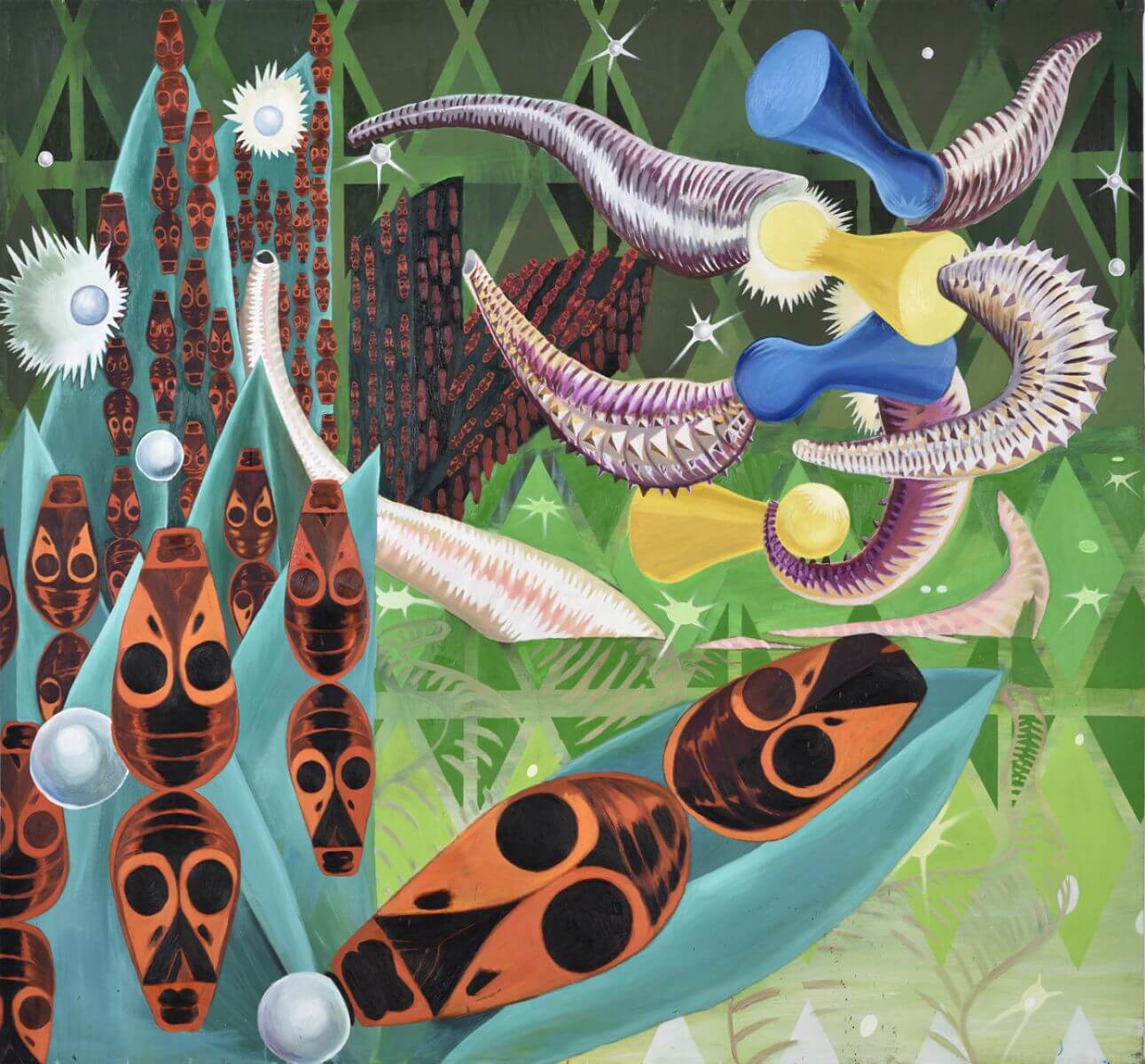
Iva Tratnik, Mating Season Totalitarianism, 2014, oil on canvas, 210 x 194 cm
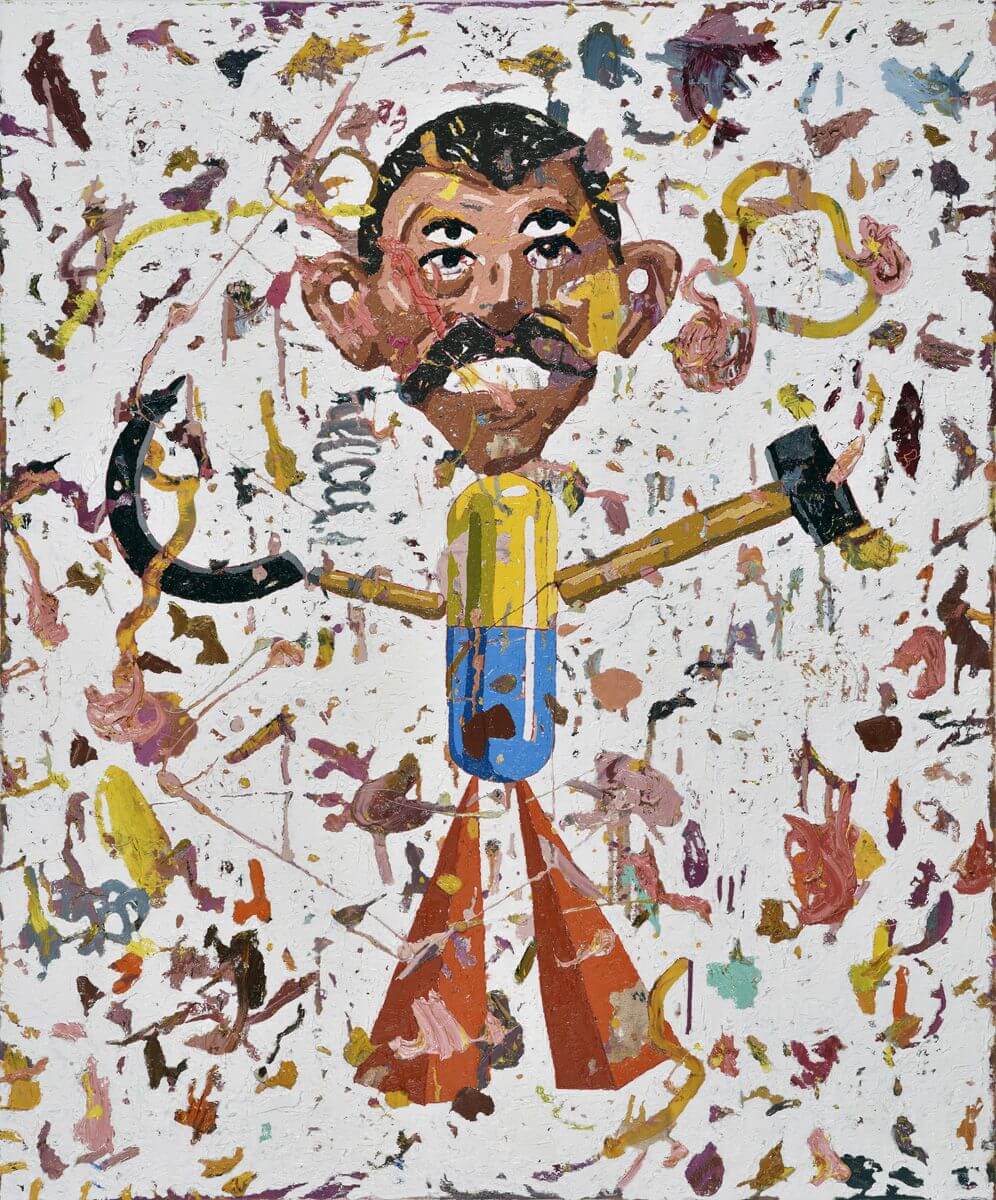
Arjan Pregl, from the Carnival series, oil on canvas (6 paintings 120 x 100 cm; 3 paintings 80 x 60 cm), 2018. Mr Pregl was recently voted "worse than Hitler" on Twitter.
National Gallery – The country’s main gallery has “the best” of what’s on offer from the Middle Ages to non-contemporary modern visual arts, and is in a great location for exploring other areas, just by Tivoli Park and opposite the main branch of the Moderna galerija. You can read about our visit to the room containing sacred art from the Middle Ages here.
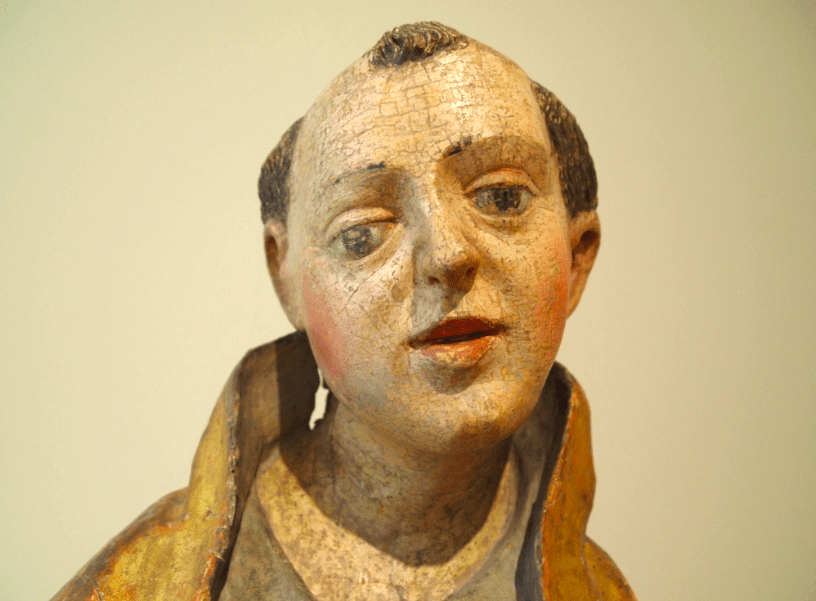
JL Flanner
The real Robba Fountain can be found in the entrance to the National Gallery - the one you see in the Old Town is a genuine fake, as seen below and reported here.

Photo: JL Flanner
National Museum of Slovenia – There’s plenty to see in the permanent collection here, from Roman times, Egypt and more. Meanwhile, the museum's Metelkova branch, located between one branch of the Moderna galerija and the Ethnographic Museum has some rooms on Church art, furniture and weapons, with the latter including more guns than you'll see anywhere else in town, and quite a thrill if coming from a nation where such objects are not household items.
Natural History Museum – On until the end of June 2019 is Our Little Big Sea, which takes a look at the oceans.
Slovene Ethnographic Museum – The museum currently has a temporary show on Bees and Beekeeping, on until June 16 2019, as well two permanent exhibitions. One of these is called Between Nature and Culture, and has a great collection of objects from Slovenia and around the world, well worth the trip up to the third floor to see it (as recounted here). This place is located near the newer branch of the Moderna galerija and Metelkova.
Union is "the Ljubljana beer", but now both it and Laško are owned by Heineken. There are many local brews on offer around town, though, if you want to explore IPAs, stouts, wheatbeers, sours and so on Photo: JL Flanner
Union Experience – The Ljubljana-based brewer has a museum showing the history of the company, with the ticket also including access to part of the factory and a few samples of the product. You can read about our visit here.
It's not a formal museum, but if you're interested in "Yugo-stalgia" then you'll enjoy a trip to Verba, a small, privately run space that's crammed with objects and pop culture items from the era, and is conveniently located at the start of one of the short walks to the castle. It's also a great place to take pictures, if you leave a donation, and you can read more about it here.
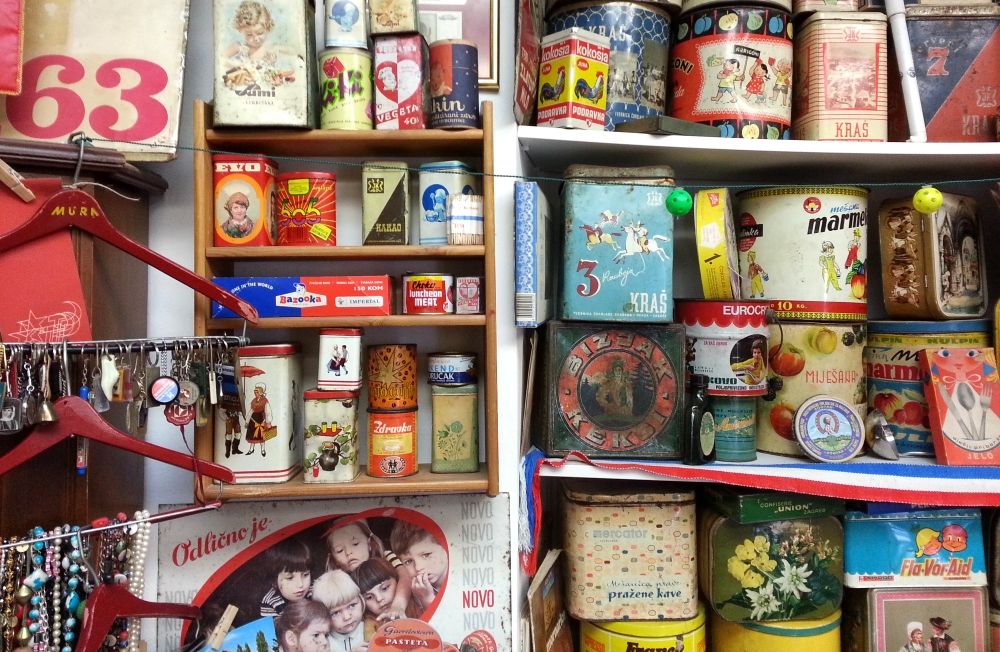
Verba. Photo: JL Flanner
Alternative Ljubljana isn't a museum or gallery, as such, but instead turns the city streets into a museum and gallery. Learn more about their tours of street art, history and LGBT Ljubljana here.

Photo: JL Flanner
Other things to do in Ljubljana
If you'd like to spend an evening painting with others, then take a look at Design with Wine, which organises painting parties on Trubarjeva cesta,
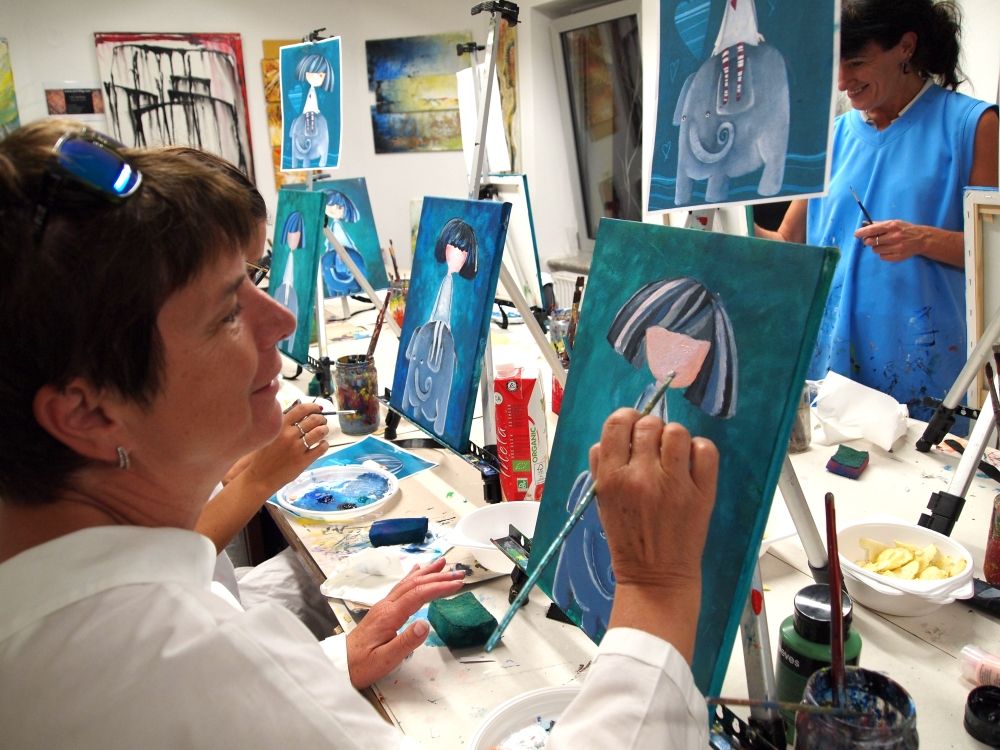
If you want to see some antiques, then check out the wonderful Antika Carniola, as discussed here. The man behind it, Jaka Prijatelj, has a fine eye for life on this street, as you can see on his Facebook account.
Photo: JL Flanner
If you’re in town and want to go jogging or walking in nature, why not take another look at the Castle, with a brief guide to the trails here. If you want something bigger, head to Tivoli Park.
And if you're bored with the Old Town, why not take a walk, cycle or boat ride to nearby Špica and enjoy the riverside life. Learn more about that here.
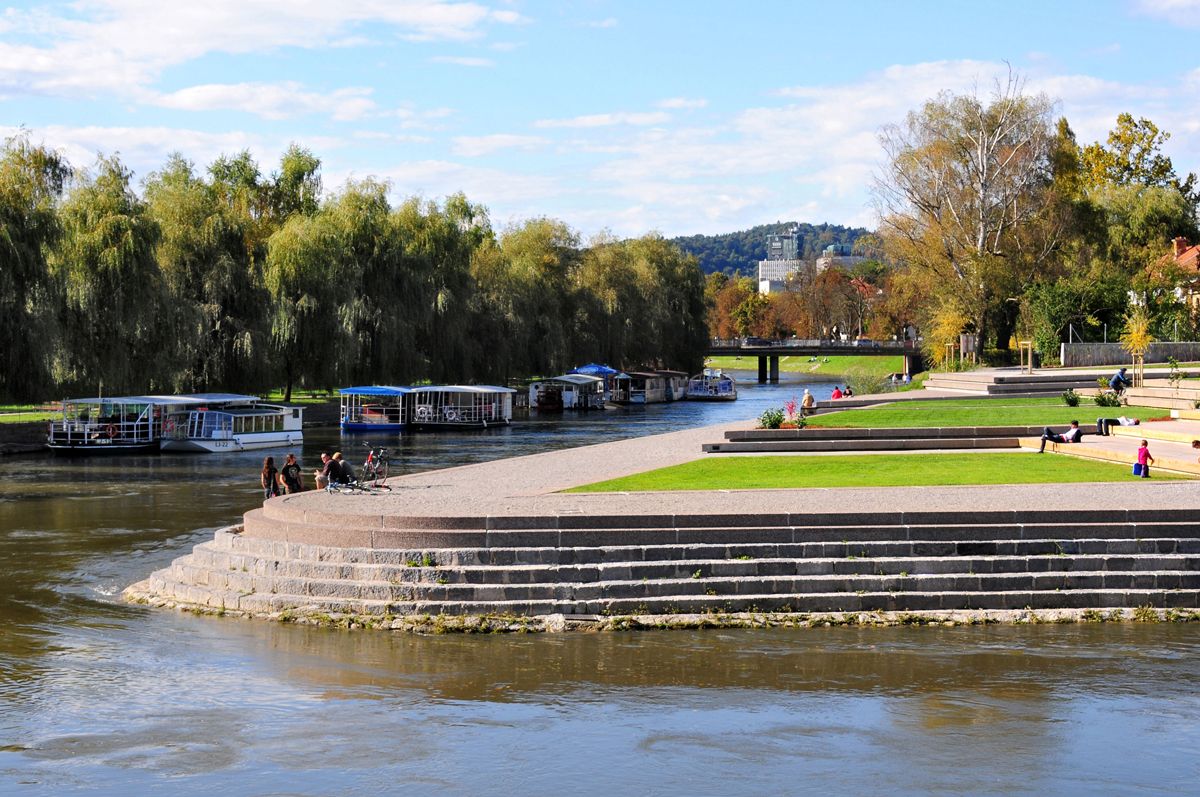
visitljubjana.si
![]()
maxpixel.net, public domain
Want to stretch and breath? Then check out our list of drop-in yoga classes for tourists, visitors and the uncommitted. If you're heading to the coast, check out our interview with a yoga teacher who offers breakfast sessions there, while if you're staying in town (or nearby) and want to try some "family yoga" then you can learn more about that here and maybe get your kids to calm down a moment or two.
Prefer to have someone else stretch you? The check out the totally legit massages you can get from Sense Wellness - either in one of their spas or in you home, office or hotel. (And - to repeat - these are legit and non-sexual in nature)
There are some golf courses near Ljubljana, but even ones further away are not far, as seen in our list of all the golf courses in Slovenia.
![]()
Photo: maxpixel.net, public domain
Daytrips
Most of Slovenia is only a few hours from Ljubljana, and you can easily visit Lake Bled, Lipica Stud Farm, Postojna Cave, Predjama Castle, the coast and other locations, while if you'd like to take a photo of from that bench in Bled, then you can learn how to get there here. If you’re looking for something more ambitious, then check out our recent guide to the 17 members of the Association of Historical Towns of Slovenia
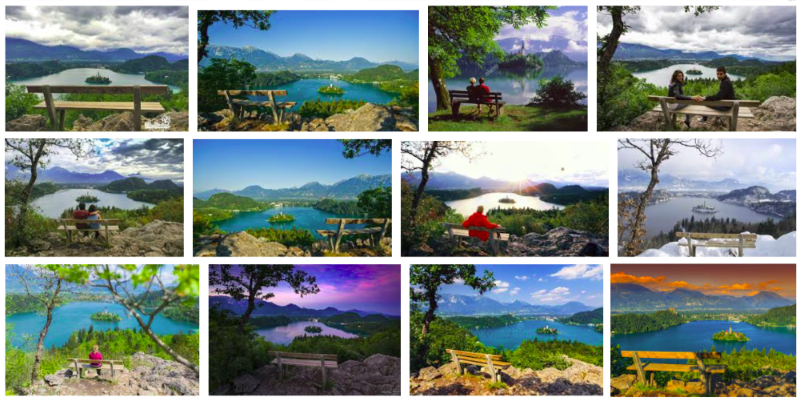
Photo: Google Image Search
Getting around & miscellaneous
If you want to get a Ljubljana Tourist Card, which gives you travel on the city buses and entry to a lot of attractions, then you can read more about that here, and if you want to use the bike share system, as useful for visitors as it is for residents, then you can learn more by clicking this. Visitors with reduced mobility will be pleased to find that downtown Ljubljana is generally rated as good with regard to accessibility, and that there’s a free, city-sponsored app called Ljubljana by Wheelchair highlighting cafés, attractions and so on with ramps, disabled bathrooms and Eurokey facilities, which you can read about and download here. Manual wheelchair users can also borrow, for free, an attachment that will motorise their equipment, as reported here.
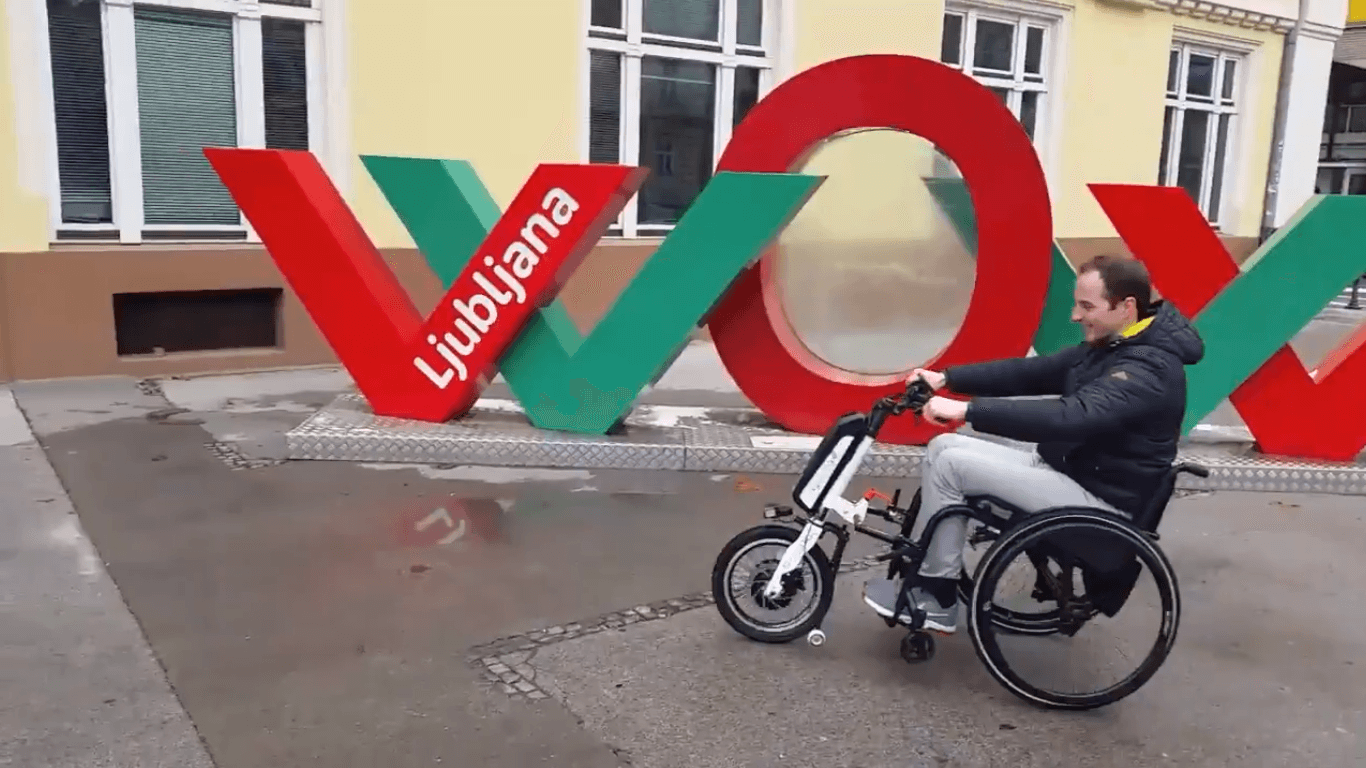
Screenshot from a Twitter video
If you’re driving into town and don’t know where to part, our guide to how to park in Ljubljana is here.
There aren't many places to eat after midnight, and most of them are by the train station, as reported here.
Want / need cigarettes but the stores have closed? Here's an incomplete list of bars downtown that will satisfy your craving for the demon weed. While if you’re having trouble with the ATMs then here’s a guide to the Slovene you’ll see on screen. If you get a hangover then find out where to get paracetamol (and prescription drugs) in Ljubljana here, while details on emergency birth control can be found here.
Ljubljana is a small and relatively safe city, but if need to contact the police then there’s a special number for foreigners, and that’s 113.
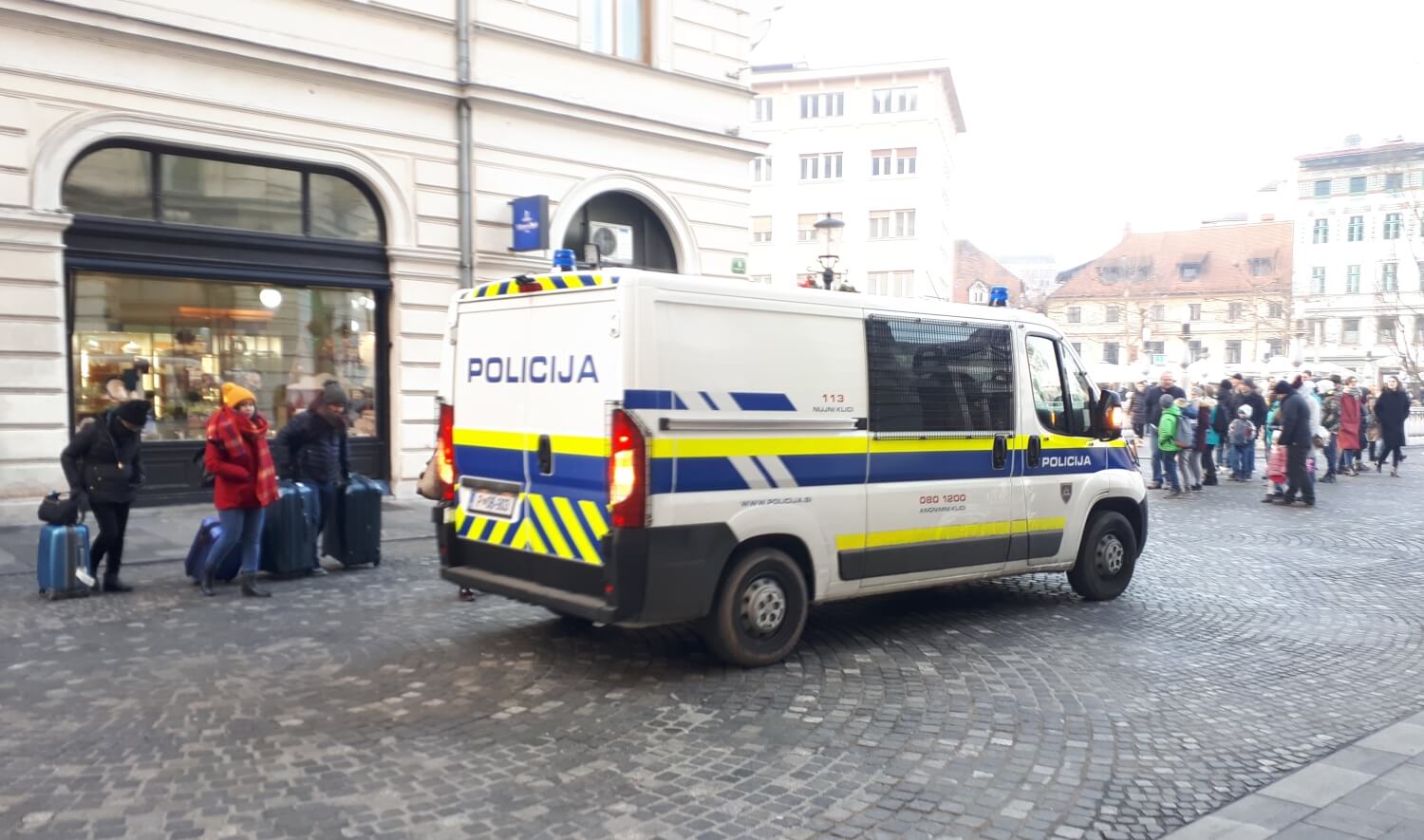
Photo: JL Flanner



